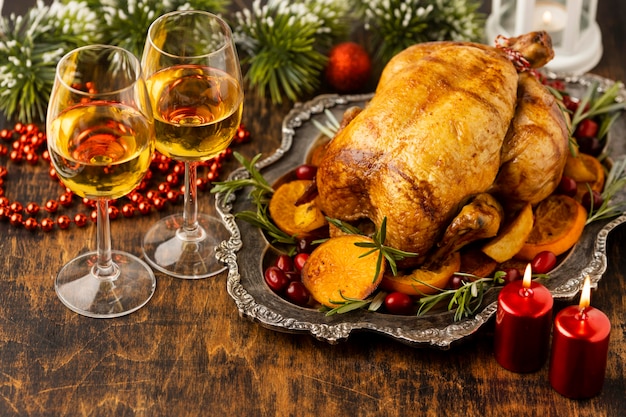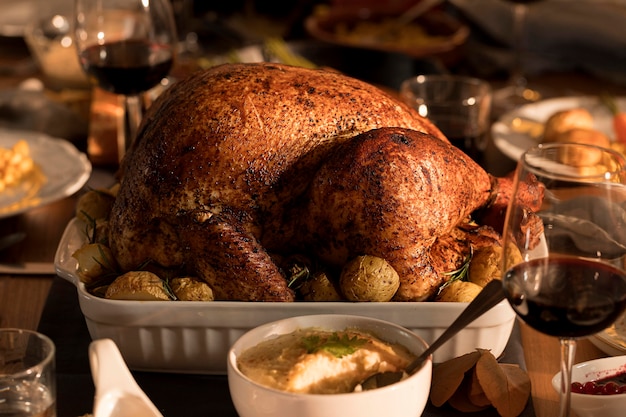(Part 1) The Essential Prep: Laying the Foundation for Success

Before we dive into the nitty-gritty of those cooking times, let's get the fundamentals sorted. First and foremost, your turkey needs to be thawed properly. Absolutely no skipping this step – putting a frozen turkey straight into the oven is a recipe for disaster (and a very long cooking time, not to mention a less-than-delicious result!).
Thawing Techniques:
- Refrigerator thawing is the gold standard. Place your turkey on a large plate or in a roasting pan, ensuring it's positioned within a container that catches any drips. It's absolutely crucial to maintain a fridge temperature below 40°F (4°C) to prevent any nasty bacteria from growing.
- Cold water thawing can be a lifesaver in a pinch. Submerge the turkey in a large container of cold water, making sure it's fully submerged. Remember to change the water every 30 minutes to keep it chilly. This method significantly cuts down thawing time, but cook the turkey immediately after thawing. Don't let it hang around!
- Never thaw a turkey at room temperature. It's a big no-no, as it creates a breeding ground for bacteria, putting your thanksgiving feast (and your guests) at risk.
Once your turkey is happily thawed, it's time to consider stuffing. I personally adore stuffed turkey, but I understand some folks prefer to cook it separately. Both methods have their pros and cons, and it ultimately boils down to personal preference. Just remember, if you choose to stuff the turkey, do it right before popping it into the oven. You want that stuffing cooked through at the same time as the turkey, no soggy, cold stuffing allowed!
(Part 2) The Golden Rule: Cooking Time Per Pound

Now, let's get to the heart of the matter – cooking times. The general rule of thumb is to allow 15-20 minutes per pound of unstuffed turkey. But, as with most things in life, there's a little more to it than that. If you're stuffing your turkey, add an extra 30 minutes to the total cooking time. And if your turkey is sporting its skin, it'll need a tad longer to cook than a brined turkey, as that skin acts as a barrier.
How Long Will It Take? A Timetable for Your Turkey:
Here's a quick breakdown of estimated cooking times for unstuffed turkeys, based on their weight:
| Weight (lbs) | Cooking Time (mins) |
|---|---|
| 8-12 | 120-180 |
| 12-16 | 180-240 |
| 16-20 | 240-300 |
Keep in mind that these are just estimates. Your oven's temperature, the type of turkey, and whether you've brined it will all play a role in the actual cooking time. Always check the internal temperature of the turkey with a meat thermometer to ensure it's cooked to perfection. No guesswork allowed!
(Part 3) Oven Temperature: Getting the Heat Right

Now, let's talk heat. The most common oven temperature for roasting a turkey is 325°F (160°C). But if you're feeling adventurous, try 350°F (175°C). Just remember, the higher the temperature, the faster the cooking time. So, if you're going with a hotter oven, adjust your total cooking time accordingly. I've found that 325°F (160°C) delivers a beautifully browned and evenly cooked turkey, but remember, every oven is different. Find what works best for you!
(Part 4) The Crucial Check: Ensuring Your Turkey is Done
Now, the moment of truth. Checking the internal temperature of the turkey is non-negotiable. You want that bird cooked through and through! Insert your meat thermometer into the thickest part of the thigh, making sure it avoids any bone. Your turkey is done when the internal temperature reaches 165°F (74°C). For stuffing, it also needs to hit 165°F (74°C). If you've chosen to stuff the turkey, check the temperature in a few different spots to ensure everything is thoroughly cooked.
Why Temperature Matters:
- food safety First: Cooking your turkey to the correct temperature is essential for food safety. It helps eliminate any harmful bacteria that might be lurking. No room for foodborne illness at your Thanksgiving feast!
- Tender and Juicy, Not Dry and Tough: Overcooked turkey is a culinary crime! A meat thermometer helps avoid this by ensuring the turkey is cooked just right. Tender and juicy, that's the goal!
- Peace of Mind: Knowing your turkey is perfectly cooked gives you peace of mind, so you can relax and enjoy your feast without a worry.
(Part 5) Rest Time: Let Your Turkey Unwind
Okay, your turkey is cooked to perfection, but don't be tempted to carve it right away. Give it a good 15-20 minutes to rest before carving. This allows the juices to redistribute throughout the meat, resulting in a moister and more flavorful turkey. Cover it loosely with foil to keep it warm while it relaxes.
(Part 6) The Carving Ritual: A Feast for the Senses
The moment of truth! After the turkey has had its rest, it's time to carve it. Grab your sharp carving knife and let the slicing begin! I love to carve the turkey in front of everyone, so they can witness its juicy, tender perfection. But hey, if you prefer a more private carving session, that's totally fine! Just remember to distribute the breast meat, leg meat, and wings evenly among your guests. Nobody wants to feel left out!
Carving Tips:
- Sharp Knife, Sharp Results: A dull knife will tear the meat, making your carving look messy. Sharp is the way to go!
- Start with the Breast: Slice the breast meat across the grain, removing the bone if necessary.
- Legs and Thighs Next: Separate the leg from the thigh, then slice the meat off the bone.
- Don't Forget the Wings: Slice those wings into smaller pieces for easy eating.
(Part 7) The Leftover Love: Transforming Turkey into Culinary Treasures
The turkey magic doesn't end with the main meal! Those leftovers are a true gift, offering a world of flavour possibilities. Think turkey sandwiches, turkey soup, turkey salad, and even turkey pie. Get creative and don't let those delicious leftovers go to waste! They're too good to be forgotten!
(Part 8) The Secret Weapon: Brining
Now, let's talk about a secret weapon that can seriously elevate your turkey game – brining. Brining involves soaking the turkey in a saltwater solution for several hours, which helps tenderize the meat and keep it incredibly juicy. It's a simple process, but it can make a massive difference in the flavour and texture of your turkey. Trust me, it's worth the extra effort!
how to brine a turkey:
- Create the Brine: Dissolve 1 cup of salt in 1 gallon of cold water. Feel free to add other ingredients to your brine, like herbs, spices, or citrus fruits. Get creative!
- Submerge the Turkey: Place the turkey in a large container and pour the brine over it, ensuring it's completely submerged.
- Refrigerate for 12-24 Hours: The longer you brine the turkey, the more tender it will become. Patience is key!
- Rinse and Dry: Before roasting, rinse the turkey under cold water to remove any excess salt. Pat it dry with paper towels.
(Part 9) The Great Turkey Debate: Stuffed vs. Unstuffed
The age-old question: stuffed or unstuffed turkey? It's a debate that's been going on for generations! Personally, I'm a big fan of stuffed turkey, but I understand that some folks prefer to cook the stuffing separately. It really comes down to personal preference.
The Case for Stuffed Turkey:
- Flavor Fusion: The flavors of the stuffing infuse the turkey, creating a harmonious blend of deliciousness.
- Convenience: Having the stuffing cooked inside the turkey simplifies meal prep. One less dish to worry about!
- Tradition: For many families, stuffed turkey is a beloved holiday tradition, passed down through generations.
The Case for Unstuffed Turkey:
- Safety First: Cooking stuffing separately ensures it reaches a safe internal temperature, reducing the risk of foodborne illness. Safety is always paramount!
- Moisture Matters: Cooking the turkey unstuffed helps prevent the breast meat from drying out, keeping it juicy and flavorful.
- Flexibility: You can cook the stuffing in different ways, like in a casserole dish or baked separately, giving you more creative control.
(Part 10) FAQs: Getting Your Turkey Questions Answered
1. Can I Roast a Turkey in a slow cooker?
Yes, you can! But it's best to use a slow cooker specifically designed for roasting. You'll also need to work with a smaller turkey, as most slow cookers can only accommodate a 5-7 pound bird. The cooking time will be longer than in a conventional oven, but the results can be truly delicious.
2. Can I Freeze a Cooked Turkey?
Yes, you can freeze cooked turkey. Place it in an airtight container or freezer-safe bag and freeze for up to 4 months. Thaw it in the refrigerator before reheating. Remember to reheat the turkey thoroughly to ensure food safety.
3. How Do I Keep My Turkey Moist?
There are several techniques for keeping your turkey moist. Brining is a great option, as it helps retain moisture. You can also baste the turkey with butter or broth during cooking. And remember, letting the turkey rest for 15-20 minutes before carving allows the juices to redistribute, resulting in a succulent feast.
4. How Do I Achieve a crispy skin?
For that irresistible crispy skin, pat the turkey dry with paper towels before roasting. Rubbing the skin with butter or olive oil adds extra flavor and helps achieve that golden brown, crispy finish. During cooking, try to avoid basting with broth, as it can make the skin soggy.
5. What are Some Good side dishes to Serve with Turkey?
The options are endless! Classic side dishes include mashed potatoes, stuffing, gravy, cranberry sauce, green bean casserole, and sweet potato casserole. But feel free to get creative! Roasted vegetables, salads, or even a fruit salad add a lighter touch to your Thanksgiving table.
Well, there you have it! A comprehensive guide to conquering your stuffed turkey cooking time. Remember, this is just a guide, and the best way to ensure your turkey is cooked to perfection is to use a meat thermometer. Don't be afraid to experiment and find what works best for you. Most importantly, have fun, relax, and enjoy the process! Happy cooking!
Everyone is watching

Prime Rib Roast Cooking Time Chart: Per Pound Guide
Cooking TipsPrime rib roast. Just the name conjures images of lavish dinners, crackling fires, and hearty laughter. It’s ...

How Long to Bake Potatoes in the Oven (Perfect Every Time)
Cooking TipsBaked potatoes are a staple in my kitchen. They're incredibly versatile, delicious, and surprisingly easy to m...

Perfect Rice Every Time: The Ultimate Guide to Cooking Rice
Cooking TipsAs a self-proclaimed foodie, I've always been a bit obsessed with rice. It's the foundation of countless cuisi...

The Ultimate Guide to Cooking Asparagus: Tips, Techniques, and Recipes
Cooking TipsAsparagus. The mere mention of this spring delicacy conjures up images of vibrant green spears, crisp and burs...

Ultimate Guide to Cooking the Perfect Thanksgiving Turkey
Cooking TipsThanksgiving. Just the word conjures up images of overflowing tables laden with delicious food, the scent of r...
